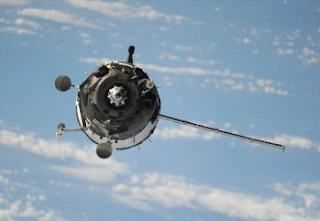Liftoff of Soyuz TMA-17M from Baikonur launch site. NASA TV.
Since the landing of Expedition 43, the International Space Station crew has been reduced to only three occupants: Commander Genady Padalka (Roscosmos), and year-long residents Mikhail Konienko (Roscosmos) and Scott Kelly (NASA), who make up the core of Expedition 44. Blasting off from the Russian space center at Baikonur, the Soyuz FG booster sent the Soyuz spacecraft into a short-duration orbital path to the ISS. After deployment, it was learned that the Soyuz spacecraft could only deploy one of the craft's twin solar panels.
Previous non-deployment of solar panel, this one was TMA-14M.
The Soyuz docked with the ISS, and the action must have jarred something loose as the ISS crew noted that the panel had then deployed. The same event conclusion happened to a previous mission, on Soyuz TMA-14m.
On his way: Astronaut Kjell Lindgren rides the cramped cockpit of a Soyuz spacecraft. The little R2D2 toy at the top of the picture hangs from the control panel during ascent, indicating the acceleration force.
The Russian mission control at the Korolev Space Center in Moscow monitors the second stage separation.
Russian cosmonauts in the center and left side of the capsule. Having reached zero-G, the R2D2 toy floats aimlessly near the control panel.
Transfer complete. The crew of TMA-17M (in front, L-R: Kimiya Yui (Japan), Oleg Kononenko (Russia), and Kjell Lindgren (NASA), join Expedition 44.














